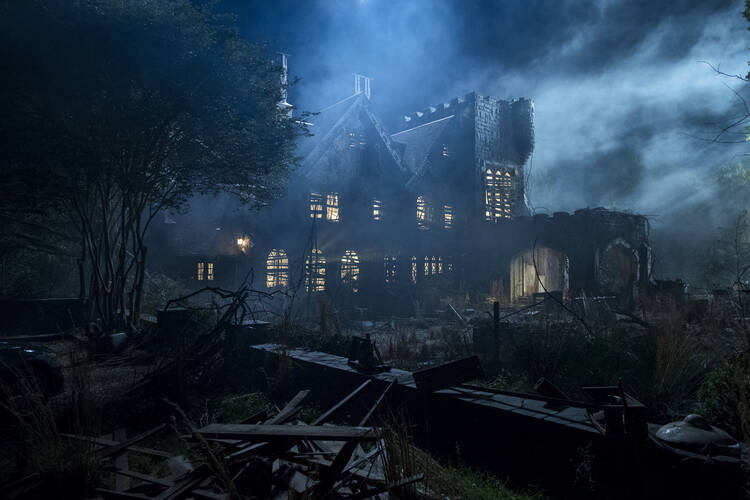In 1959, Shirley Jackson wrote The Haunting of Hill House. The gothic horror novel, described by NPR as “one of the finest haunted house novels of the 20th century,” follows John Montague, a supernatural investigator. Jackson writes that Montague “had been looking for an honestly haunted house all his life.” He decides to rent Hill House for three months hoping to find evidence of the supernatural.
Three strangers—Eleanor, Theodora and Luke—join Montague along with the caretakers of Hill House, Mr. and Mrs. Dudley. The four visitors meet for the first time at Hill House, and throughout their time there they experience the “darkness within” the home. Jackson alludes to supernatural elements in The Haunting of Hill House, but her protagonists are never explicitly haunted; they are instead tormented by traces of ghosts. Tyler Coates in Esquire writes that part of the horror in the novel lies in the sparseness of Jackson’s writing. The author “maintains control of her story (and her reader’s fears) by not bringing any ghosts to the surface,” he writes, adding, “The scares are all internalized.”
The latest adaptation of the horror novel, Netflix’s “The Haunting of Hill House,” turns the psychological horrors of Jackson’s novel and into one of the most terrifying works of TV horror in recent years.
While Jackson kept the ghosts in her novel just below the surface, Mike Flanagan, the show’s creator, throws the supernatural right in our faces.
The 10-episode series, released last month on the streaming service, follows parents Hugh and Oliva Crain and their five children: Steven, Shirley, Theodora and twins Luke and Nell. Hugh and Olivia are renovating Hill House to try and sell it for profit. As the show flashes between past and present, we see that the Crain family spent a summer there. In each episode, we are treated to each family member’s perspective on the summer and the effects it has had on them. As each episode builds, we watch the ghosts of Hill House torment the family. While in Jackson’s novel the characters sense they are being haunted when they experience strange noises and fleeting visions, there is little room for doubt for the characters in the series, where protagonists come face-to-face with their ghosts. Nell is haunted by a gruesome specter she names “The Bent-Neck Lady”; Shirley hears banging around the walls of her room that can’t be explained away by radiators clamoring in the night; Luke is attacked by a crawling skeleton while trapped in the basement; Olivia becomes possessed by Hill House itself.
While Jackson kept the ghosts in her novel just below the surface, Mike Flanagan, the show’s creator, throws the supernatural right in our faces. Every episode contains a jump scare, including the very first viewing of The Bent-Neck Lady standing at the foot of Nell’s bed in Episode 1.
But the show is terrifying beyond the jump scares. Flashbacks and flashforwards track how the entire family is torn apart by Hill House, long after they leave the grounds. The Crain family loses Olivia after she commits suicide following her possession. Along with the supernatural fears of the “The Haunting of Hill House,” Flanagan shows audiences the variety of ways Olivia’s death—and the ghosts of Hill House—has affected the Crains years later. Shirley grows up to be a mortician, obsessed with death and helping families grieve; Steven refuses to believe in ghosts, labeling his family as crazy; Luke is an addict with multiple rehab stints; Nell repeats her mother’s actions and commits suicide—or is killed by Hill House. The show blurs the line between mental illness and supernatural hauntings.
No member of the Crain family is the same after their summer at the home. They are internally changed, most dealing with post-traumatic stress disorder, and their relationships with one another are fractured.
In an interview with Vulture, creator Mike Flanagan states that he has always been drawn to familial horror. “For me, The Haunting of Hill House is a series about life after a haunting, what happens after the credits roll in most horror films. When you talk about people being haunted or wrestling demons, that is a rich metaphor.”
What makes “The Haunting of Hill House” so terrifying is not just the ghosts, but the familial devastation they leave in their wake.











When a horror story gives you the thrills, the feels, the screams and the tears. You know that this is going to be something otherworldly astonishing, This movie is available on Morph TV app (https://morphtvapp.com)
America Magazine needs a comments editor to get rid of all the advertising trash that pops up.